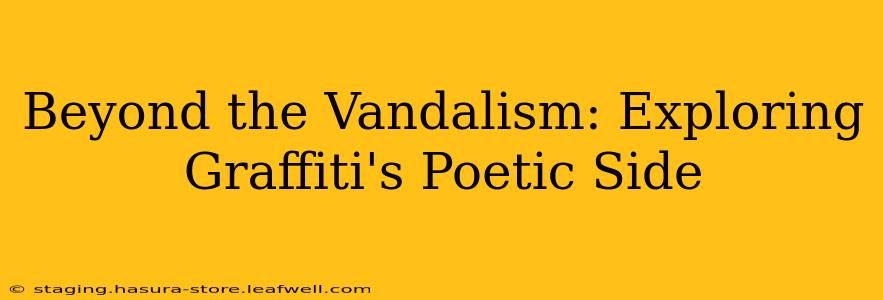Graffiti. The word itself conjures images of defaced walls, illegal tagging, and urban blight. But beyond the vandalism, a vibrant and often overlooked art form thrives—one brimming with poetic expression, social commentary, and raw creativity. This exploration delves into the poetic heart of graffiti, revealing its power to communicate, inspire, and even heal. We'll move beyond the negative connotations and uncover the rich tapestry of meaning woven into its vibrant strokes.
What is the difference between graffiti and street art?
This is a frequently asked question, and the line can be blurry. Graffiti, in its purest form, is typically unauthorized marking or writing on property. It can range from simple tags (signatures or stylized names) to elaborate murals. Street art, on the other hand, often involves more complex imagery and narratives, and while sometimes unauthorized, it's frequently commissioned or tolerated, existing in a grey area between vandalism and public art. The key difference often lies in the intent and the level of artistic sophistication, though the two frequently overlap. Many graffiti artists transition into creating street art as their skills and ambitions evolve.
Is graffiti art a crime?
Yes, in most jurisdictions, graffiti is considered a crime, specifically vandalism or property damage. The penalties can vary significantly depending on the extent of the damage, the location, and local laws. This legal reality is a significant part of the graffiti subculture, often fueling the adrenaline rush and clandestine nature of the art form. However, it's important to note the growing acceptance of street art, which often operates within a legal framework through permits and collaborations with property owners.
What are some examples of poetic graffiti?
Poetic graffiti transcends simple tagging. It uses words and imagery to evoke emotion, tell stories, or express social or political messages. Think of pieces that incorporate powerful metaphors, evocative language, or poignant imagery. For instance, a mural depicting a wilting flower amidst concrete might symbolize the decay of the environment, communicating a powerful message with minimal words. Other examples might include stylized lettering that evokes a sense of rhythm and flow, mirroring the structure of poetry itself, or pieces that cleverly use wordplay and puns to create a layered meaning. The poetry lies not only in the message but also in the artistic execution—the bold colors, skillful lettering, and the very act of placing art in unexpected places.
How does graffiti contribute to the community?
While often viewed negatively, graffiti can actually contribute positively to a community. In revitalized urban areas, commissioned murals can brighten up neglected spaces, transform drab buildings, and increase a sense of community pride. Moreover, graffiti can serve as a powerful form of social commentary, highlighting issues of inequality, injustice, or environmental concerns that might otherwise go unnoticed. By engaging with the community's lived experiences, graffiti can act as a catalyst for dialogue and social change, even if the initial act of creation was illegal. This is especially true when considering the historical role graffiti has played in social movements around the world.
What are the different styles of graffiti?
The world of graffiti boasts a wide range of styles, each with its own aesthetic and technical challenges. From simple tags and throw-ups (quickly executed pieces) to intricate wildstyle (complex, interwoven lettering) and murals featuring detailed imagery, the stylistic diversity is staggering. Each style demands a different level of skill and experience, showcasing the evolving skill of graffiti artists as they progress. Understanding the technical aspects of the various styles allows for a deeper appreciation of the artistry involved.
Conclusion: A Deeper Understanding
Graffiti, beyond the initial perception of vandalism, offers a rich landscape for artistic expression and social commentary. Understanding its poetic side allows us to appreciate the skill, creativity, and often powerful messages embedded within the art. While the legality remains a complex issue, exploring the artistic merits and societal contributions of graffiti helps cultivate a nuanced perspective, recognizing its potential to transform urban spaces and engage in broader societal conversations. The next time you encounter graffiti, take a moment to look beyond the surface and consider the poetic message it might be trying to convey.

